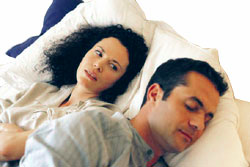- What is Hypoactive Sexual Desire Disorder (HSDD)?
- Statistics
- Risk Factors
- Progression
- Symptoms
- Clinical Examination
- Treatment
- References
What is Hypoactive Sexual Desire Disorder (HSDD)?

This definition is based on the traditional model of human sexual response. It is important to note that this model derived from studies on predominantly male subjects, emerging from the work of William Masters and Virginia Johnson, and later expanded by Helen Singer Kaplan. This linear male based model states that desire precedes arousal, orgasm, and resolution. It has traditionally been used for teaching about human sexuality, for diagnosing dysfunctions and disorders, and for both pharmacological and non-pharmacological treatment planning.
However, research has made it clear that sexual desire that takes the form of sexual fantasising, yearning, and looking forward to sexual experiences – in other words, this ‘spontaneous’ desire – is infrequent in many sexually functional and satisfied women, especially those in established relationships. It is now recognised that sexual desire can be responsive, occurring after arousal or physical stimulation, rather than a spontaneous event before arousal. For many women, it would appear that sexual arousal and a responsive type of desire occur at some point after they have chosen to experience sexual stimulation.
Moreover, studies have confirmed that women mostly accept or initiate sexual interaction for reasons other than desire, such as to increase emotional bonding, or as a response to romantic settings or more specifically erotic cues.
This research has called into question the traditional definition of HSDD and the estimated number of women with sexual desire disorder, which are based on the traditional linear model.When both responsive desire and the many aspects of sexual motivation are reflected in a model of sexual response, the structure is circular rather than linear, and reflects the overlapping of the desire and arousal phases reported by women.
This has resulted in a revised definition of HSDD for women:
Absent or diminished feelings of sexual interest or desire, absent sexual thoughts or fantasies, and a lack of responsive desire. Motivations for attempting to become sexually aroused are scarce or absent. The lack of interest is considered to be beyond a normative lessening with life cycle and relationship duration.
Statistics
Hypoactive Sexual Desire Disorder is one of the most common presenting problems in the practice of sex therapy. It is estimated that approximately 20% of men and 33% of women are affected by low or absent sexual desire.
Risk Factors
The predisposing factors for HSDD arise from four major areas:
- The individual;
- Family of origin (intergenerational);
- The couple’s relationship (interactional); and
- Medical aspects.
The individual
Psychological risk factors in the individual can be expressed within the context of sexual intimacy, giving rise to the development of HSDD. These involve:
- Anxiety;
- Depression;
- Sexual orientation conflicts;
- Negative thinking patterns;
- Inaccurate beliefs about sex;
- Poor body image;
- A tendency to fuse sex and affection;
- Career overload; and
- Related sexual problems.
Fears can also increase the risk of developing HSDD, since emotional and physical intimacies are closely related. Sexual desire may be hampered by a fear of intimacy, anger, rejection and abandonment, exposure, feelings or dependency.
Physical factors, such as sexual abuse and emotional trauma, can also inhibit desire.
Intergenerational risk factors
Many anti-sexual beliefs are learned within the social familial context. For example, when raised in an extremely religious household, an individual may learn that sex is for procreation and not personal enjoyment. This can lead to feelings of guilt and shame, and may then result in HSDD.
Interactional risk factors

Other relational risk factors can include:
- Contemptuous feelings;
- Criticism;
- Defensiveness;
- Power struggles; and
- Toxic communication.
Medical aspects
Deficiencies of testosterone or other hormones, and medical conditions that create hormone deficiencies, can have an impact on sexual desire. Chronic medical conditions, physiological changes, and medications can also contribute to HSDD. This includes:
- Depression;
- Medications, such as serotonergic antidepressants;
- Chronic debilitating illnesses, such as chronic renal failure;
- Fluctuations in blood sugar with diabetes; and
- Hyperprolactinaemia, hypo-hyperthyroid states (less common).
Arousability may also be negatively affected by:
- Androgen deficiencies;
- Lamic or pituitary disease; and
- Prolonged high-dose cortisol use.
Symptoms

An individual with a generalised lack of desire does not have a sexual appetite under any circumstances. On the other hand, an individual who experiences selective desire in certain situations or with specific partners is classified as situational type. For example, a person might feel desire toward a partner they have an affair with, but not with their established partner.
It is important to note that males with inhibited sexual desire appear to use fantasy in a different way to females with this complaint. Females with desire phase problems show low levels of fantasy, whereas men with desire phase problems show a high level of sexual fantasy.Males may use sexual fantasy to enhance their sexual performance due to response anxiety. Response anxiety is experienced when there is widespread pressure to feel sexually aroused, but arousal does not occur. Sexual fantasies may be constructed to help generate sexual arousal that is difficult to achieve without the use of fantasy.
Clinical Examination
Clinical assessment of HSDD should take into account a variety of factors related to the individual and the couple, including:
- Level of emotional intimacy;
- Mental and physical health;
- Sexual context;
- Relationship issues or concerns;
- Thoughts during sexual interactions; and
- Messages from families of origin.
Emotional intimacy

Assessment of a couple’s emotional intimacy typically includes questions about their ability to trust, be vulnerable, not be judgemental or highly critical, and to have a sexually attractive balance of power and assertiveness in the relationship.If there is greater desire and response with a new partner, the challenge may then be to remember the behaviours and interpersonal atmosphere that first led to desire for the established partner.
Mental and physical health
Assessment and management of overall mental health is vital, as is assessment of well-being at the time of sexual interaction. This includes energy levels, self-esteem, sense of attractiveness, body image, and freedom from stressful distractions and preoccupations.
Depression is strongly associated with reduced sexual function. Antidepressants, especially those that are highly serotonergic, may lessen sexual desire. Various medical conditions can also impact on a person’s level of desire.
Sexual context
A detailed assessment of a couple’s usual sexual context may lead the health professional to recommend changes. Factors that may be assessed include:
- Time of day;
- Time since last sexual activity;
- What happens in the hours preceding sexual opportunities; and
- What needs to be done after sexual activity.
The couple

When evaluating emotional contracts, the health professional will look at what is important for the couple to feel good emotionally, i.e. what is needed and what they do to feel happy. Western philosophy and psychology generally agree that happiness is good for people and distress is bad, that people seek happiness, and that it is easier to be happy when others are happy as well. To attain such conditions, it is useful to try to maximise pleasant emotions over the long term. Openness to emotion is also recognised as being important, because it permits emotional information to be recognised and coped with, thereby promoting conditions that foster happiness.
The health professional will also assess both sexual and nonsexual relational factors.
Thoughts during sexual interaction
The health professional may assess the individual’s ability to focus on sexual stimuli to determine if help is needed. Distractions regarding day-to-day stresses are common. Other distracting feelings include:
- Stress;
- Resentment;
- Sense of obligation regarding imposed sexual frequency or type of sexual interaction; and
- Prediction of negative outcome such as unwanted pregnancy, further proof of infertility, or lack of sexual satisfaction.
Intergenerational system
Family of origin factors and intergenerational factors are assessed through the use of a genogram. A genogram examines different aspects of familial functioning. Instances of incest, parentification, triangulation and other dysfunctional patterns of familial relationships that impact intimacy and sexuality will often need to be assessed.
Empirical tools
A health professional may use several tools to evaluate female clients. For general sexual dysfunction, the Female Sexual Function Index (FSFI) may be used, or the Sexual Interest and Desire Inventory-Female (SIDI-F) may be used for HSDD.
The FSFI is a validated 19-item self-report questionnaire and contains 6 domains, including desire, arousal, lubrication, orgasm, satisfaction and pain. Higher scores on the FSFI reflect better sexual function.
The SIDI-F contains thirteen items, which will be rated by the health professional (relationships-sexual, receptivity, initiation, desire-frequency, affection, desire-satisfaction, desire-distress, thoughts-positive, erotica, arousal-frequency, arousal-ease, arousal-continuation and orgasm). There are 4, 5, or 6 possible options for each item and each item contributes a score of points toward a SIDI-F total score. The score assigned to an option is based on clinical judgment about the relationship between the particular option and symptom severity. Higher scores on any particular item indicate increased levels of sexual functioning.
As yet, tools have not been developed for men.
Treatment

Medical therapies
Some prescription medications are sometimes used for sexual purposes. For example, bupropion sustained release (SR), an antidepressant, has a positive effect on various aspects of sexual function in women diagnosed with hypoactive sexual desire disorder. Bupropion SR is used to counteract HSDD caused by another group of commonly used antidepressants called selective serotonin reuptake inhibitors (SSRIs).
The side effects of many commonly used prescription medications can be a factor in HSDD. To overcome the sexual side effects of medications, a health professional may suggest:
- Waiting to see if the symptoms disappear;
- Lowering the dose;
- Substituting another medication;
- Adding a supplementary medicine to act as an antidote; or
- Discontinuing the medication for brief periods.
It is important that individuals do not make changes to their medication usage without first consulting their doctor.
Testosterone is important for sexual appetite in men and women as it promotes sexual desire, curiosity, fantasy, interest and behaviour. Testosterone deficiency in men can be treated with an assortment of products, with varying results. However, testosterone deficiency in women cannot yet be treated with medication. The relationship between testosterone and sexual desire in women is complicated. HSDD in women cannot be diagnosed by assessing the level of circulating sex hormones such as testosterone; some women with low testosterone levels do not experience desire problems, and most women with HSDD have normal testosterone levels. Testosterone does increase sexual desire and well-being in postmenopausal women with HSDD.
Sex therapy

Personal type of sexual desire
Perceiving oneself to be dysfunctional lowers sexual self-image, thus adding to the problem. A therapist will often begin by explaining the sexual response cycle and the type of sexual desire that is being experienced. Living with a type of sexual desire may be less difficult if there is an understanding that it is ‘within accepted normal limits,’ and if an individual agrees to nurture and enhance it. A sense of hope and of normality can in itself be therapeutic to both partners.
Relationship views
Within a relationship, couples often view the symptomatic partner as the one with the problem. In fact, HSDD is a relationship problem. One technique to help couples realise this is the therapeutic reframe, in which the therapist helps the couple think about HSDD in a different way. The therapist emphasises that the couple struggles together and will need to work together to resolve the problem.
Throughout the process of therapy, couples gradually learn that sexual desire and satisfaction are created, fostered, practiced and nurtured by the self and the partner, and that it is not just something that happens to one of them.
Other issues
Usually the therapist starts by focusing on the problem of sexual desire. However, during the course of treatment, other individual or relationship issues might become more important. These often include anxiety, anger, sexual ignorance or lack of communication.
Lowering response anxiety

Cognitive therapy
Cognitive therapy is a necessary part of treating HSDD. Negative thought patterns about sexual intimacy, the self and the partner directly contribute to lack of desire by preventing the emergence of enjoyable sexual thoughts and fantasies. Misinformation about sexual desire, the lack of desire, and sexuality in general must be corrected, so a therapist may provide psychoeducation at the same time.
Homework assignments
Homework assignments play an important role in treating HSDD, as they address individual, relational, and intergenerational issues associated with the lack of sexual desire. Homework for the individual may include guided imagery, directed masturbation, and exposure to fantasy. For the couple, on the other hand, homework may include sensate focus, communicating sensual and sexual wishes and needs, and conflict resolution exercises.
Kindly written by Desiree Spierings BA (Psych) MHSc (Sexual Health); Sex Therapist; Director of Sexual Health Australia and Editorial Advisory Board Member of Virtual Men’s Health and Virtual Women’s Health.
References
- Diagnostic and Statistical Manual of Mental Disorders (fourth edition). Washington, DC: American Psychiatric Association; 2000. [Publisher]
- Basson R. Sexual desire/arousal disorders in women. In: Leiblum SR (ed). Principles and Practice of Sex Therapy (4th edition). New York: Guilford Press; 2007: 25-53. [Publisher]
- Cain VS, Johannes CB, Avis NE, et al. Sexual functioning and practices in a multi-ethnic study of midlife women: Baseline results from SWAN. J Sex Res. 2003;40(3):266-76. [Abstract | Full text]
- Graham CA, Sanders SA, Milhausen RR, McBride KR. Turning on and turning off: A focus group study of the factors that affect women’s sexual arousal. Arch Sex Behav. 2004;33(6):527-38. [Abstract]
- Galyer KT, Conaglen HM, Hare A, Conaglen JV. The effect of gynecological surgery on sexual desire. J Sex Marital Ther. 1999;25(2):81-8. [Abstract]
- Laumann EO, Paik A, Rosen RC. Sexual dysfunction in the United States: Prevalence and predictors. JAMA. 1999;281(6):537-44. [Abstract | Full text]
- Basson R. The female sexual response: A different model. J Sex Marital Ther. 2000;26(1):51-65. [Abstract]
- Basson R, Leiblum S, Brotto L, et al. Definitions of women’s sexual dysfunction reconsidered: Advocating expansion and revision. J Psychosom Obstet Gynaecol. 2003;24(4):221-9. [Abstract | Full text]
- McCabe MP. A program for the treatment of inhibited sexual desire in males. Psychotherapy. 1992;29(2):288-96.
- Nutter DE, Condron MK. Sexual fantasy and activity patterns of females with inhibited sexual desire versus normal controls. J Sex Marital Ther. 1983;9(4):276-82. [Abstract]
- Weeks GR, Hertlein KM, Gambescia N. The treatment of hypoactive sexual desire disorder. In: Hertlein KM, Weeks GR, Gambescia N (eds). Systemic Sex Therapy. New York: Routledge; 2008: 81-106. [Publisher]
- Morokoff PJ, Gilliland R. Stress, sexual functioning, and marital satisfaction. J Sex Res. 1993; 30(1):43-53. [Abstract]
- Avis NE, Zhao X, Johannes CB, et al. Correlates of sexual function among multi-ethnic middle-aged women: Results from the Study of Women’s Health Across the Nation (SWAN). Menopause. 2005;12(4):385-98. [Abstract]
- Wiegel M, Meston C, Rosen R. The female sexual function index (FSFI): cross-validation and development of clinical cutoff scores. J Sex Marital Ther. 2005;31(1):1-20. [Abstract | Full text]
- Clayton AH, Segraves RT, Leiblum S, et al. Reliability and validity of the Sexual Interest and Desire Inventory-Female (SIDI-F), a scale designed to measure severity of female hypoactive sexual desire disorder. J Sex Marital Ther. 2006;32(2):115-35. [Abstract]
- Weeks G, Treat S. Couples in Treatment: Techniques and Approaches for Effective Practice. New York: Brunner-Routledge; 2001. [Publisher]
- Gambescia N, Weeks G. Sexual dysfunction. In: Kazantzis N, L’Abate L (eds). Handbook of Homework Assignments in Psychotherapy: Research, practice, and prevention. Norwell, MA: Kluwer Academic Publishers; 2007: 351-68. [Publisher]
- Basson R. Using a different model for female sexual response to address women’s problematic low sexual desire. J Sex Marital Ther. 2001;27(5):395-403. [Abstract]
- Segraves RT, Clayton A, Croft H, et al. Bupropion sustained release for the treatment of hypoactive sexual desire disorder in premenopausal women. J Clin Psychopharmacol. 2004;24(3):339-42. [Abstract]
- Krapf JM, Simon JA. The role of testosterone in the management of hypoactive sexual desire disorder in postmenopausal women. Maturitas. 2009;63(3):213-9. [Abstract]
All content and media on the HealthEngine Blog is created and published online for informational purposes only. It is not intended to be a substitute for professional medical advice and should not be relied on as health or personal advice. Always seek the guidance of your doctor or other qualified health professional with any questions you may have regarding your health or a medical condition. Never disregard the advice of a medical professional, or delay in seeking it because of something you have read on this Website. If you think you may have a medical emergency, call your doctor, go to the nearest hospital emergency department, or call the emergency services immediately.








